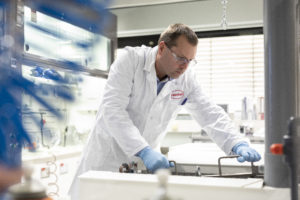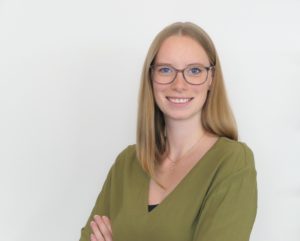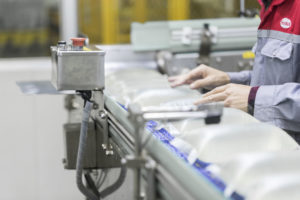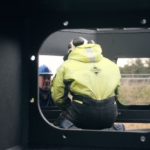Henkel will be presenting at the Global Urban & Advanced Air Summit (GUAAS) for the first time this year, sharing more than 50 years of experience in manufacturing aerospace coatings and structural adhesives for the aircraft OEM and MRO industries.
The company is listed in over 5,000 aerospace specifications and offers support in all elements of designing and manufacturing lightweight aircraft. Henkel has a portfolio of aircraft building supplies from aerospace grade adhesives, sealants, and epoxies, to coatings and assembly films.
As the aerospace industry has evolved, Henkel has adapted its activities with it. In the last few years, the industry has been driven by digitisation, automation, improved maintenance, new sustainable material solutions, and the emergence of the new urban air mobility transportation sector.
Within the UAM, Henkel is already working to provide solutions within structural bonding, thermal interface materials, NVH damping materials, , adhesives and primers for windshield bonding and composite solutions.
FINN’s Digital Content Editor Katherine Simmons caught up with Mareike Noack, Henkel’s Market Segment Manager for UAM, ahead of the company’s very first attendance at GUAAS to find out more…
KS: Can you describe Henkel’s activity at GUAAS 2022?
Mareike Noack (MN): “The UAM market at the moment is all about cooperation, supporting and overcoming the challenges, of course, and this can be better achieved with networking and face-to-face interactions. GUAAS is a great platform for meeting thought leaders of the industry but also OEMs and tier suppliers which are working on the foundation of this market.
“Henkel is attending GUUAS to present where we come from and how we can contribute to develop the UAM sector.”
KS: What experience will Henkel bring from other sectors, such as automotive and aerospace, to UAM?
 MN: “Across our company, we have a history of expertise in aerospace, space and defense sectors with our adhesives and coatings. Now engineers and technicians have developed and qualified our products on more than 5000 Aerospace OEM specifications; everything from structural materials like film or paste, composite materials and MRO solutions. We do have a lot of experience in electronics, electronically conductive adhesives, thermal interface materials which we apply now on the drone segment as well.”
MN: “Across our company, we have a history of expertise in aerospace, space and defense sectors with our adhesives and coatings. Now engineers and technicians have developed and qualified our products on more than 5000 Aerospace OEM specifications; everything from structural materials like film or paste, composite materials and MRO solutions. We do have a lot of experience in electronics, electronically conductive adhesives, thermal interface materials which we apply now on the drone segment as well.”
“When we look into leveraging the expertise from adjacent industries, the one that always counts is e-mobility and automotive. In the last years, the sector has developed solutions for electrification, which is now coming to Aerospace and Advanced Air Mobility.”
“The heart of an eVTOL is the power system. We’ve seen battery technology improving in the automotive sector and it has been able to respond to the new requirements. We use, for example, our expertise for thermal runaways solutions and heat dissipation. Also, we apply materials from automotive into the UAM batteries to achieve high reliability and quality standards. What we definitely leverage from aerospace, besides the product range, is the certification process and quality demands.”
KS: Henkel’s preference is to partner with UAM leaders early in the design phase. Can you describe some of the issues that you might be able to overcome when you are able to support design teams in these early stages?
MN: “Some materials, especially within the electronics area, need to have good compatibility with each other. If a design is halfway finished and a potential customer comes to us in the very last minute, we might not have the perfectly fitting product – but in an earlier stage, we can support him with a broad range of products which bring high reliability together with the required thermal or conductive characteristic and the compatibility. So, we can offer the customer the right solution throughout the entire process chain. In the end, the main goal is to ensure quality and reliability.”
“Another issue that industry faces is the certification timeline. We cannot shorten them – high aerospace quality standards need to stay – but with extensive knowledge about products and specifications, we can guide and support customers during the testing phase giving them more time to achieve their timelines. It’s not only designing, but it’s having the capital and the experience to get these designs through that process. That is going to lead to the development and the deliveries of these amazing new aircraft.”
“A lot of our aerospace products are already certified for certain specifications. So, it could be that the potential customer is aligning their specifications to our specification, for example. But if UAM leaders want their own specification, we can support them in this process as well.”
KS: What influence will Henkel’s established venture capital network, which has a focus on innovations and partnerships, have on the emerging UAM sector?
MN: “We are always looking towards material science start-ups that are focusing on new technologies or breakthrough ideas to serve new markets such as the UAM. For UAM, for instance, the major driver is miniaturisation of electronic applications and heat dissipation. Looking into this area will definitely complement our portfolio.”
Within the aerospace sector, there are many challenges before a start-up can even get to launch a product. Henkel already has the outreach to major UAM and OEMs and can introduce start-up products to these customers. This is a win-win situation for both, OEMs and start-ups; it is all about accelerating their growth.”
KS: With the industry committing to net zero carbon emissions by 2050, can you describe how Henkel will be meeting these ambitions across its operations?
MN: “In light of the Paris Agreement on climate change and the clear need to reduce CO2 emissions, Henkel is pursuing the vision to become a climate-positive company by 2040 and to drive significant progress in other relevant areas of its value chain.”
“We are aiming to reduce the carbon footprint of our operations by 65 percent by 2025 and by 75 percent by 2030. We intend to achieve this by continuously improving our energy efficiency and by using electricity exclusively from renewable sources. Our target for this is to source 100 percent electricity from renewable sources by 2030.”
“We want to become climate-neutral by replacing the remaining fossil fuels used in our operations with CO2-free alternatives. Our operations will become climate-positive when surplus carbon-free energy that Henkel does not need for its own purposes is supplied to third parties.”
“In addition, we want to influence the key levers in our value chain and leverage our technologies to help our customers and consumers save CO2 emissions. It is our target that 100 million tons of CO2 are saved together with our customers and suppliers in the ten-year period 2016-2025. We also want to reduce the footprint of the raw materials and packaging that we use by 30 percent by 2030.”
KS: And finally… what aspects of GUAAS will you be most looking forward too?
MN: “Definitely meeting both leaders and teams within the UAM market and presenting how Henkel can support the on-going race for quality and the best fitting technology for our customers’ needs. It is all about engaging with thought leaders in this exciting market.”
Henkel will be sharing how they can support the UAM market with their broad technology and product portfolio, along with a deep dive into selected technologies, at GUAAS on March 3 and 4

